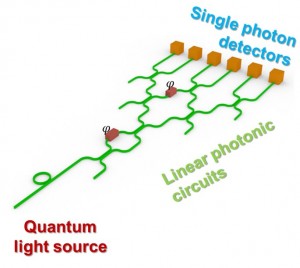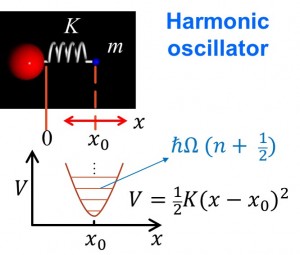Nano-photonics is the study of the behavior of light in micro-/nano-sized structures, often smaller than light wavelength.
In nano-photonic structures, light can be transferred, modified, absorbed, rotated, and newly generated. Due to the high refractive index contrast between silicon and cladding material, a small volume of light confinement can be readily achieved with the advantages of
(1) Strong light-matter interactions inducing quantum/nonlinear optical behaviors,
(2) Minimization of an optical system,
(3) System stabilization due to monolithic on-chip optical systems,
(4) Scalability of the system.
In Shin Lab, we study novel physics due to dramatically enhanced nonlinear optical effects in such a small scale with following projects.
Correlated photon pairs can be generated through a silicon waveguide and silicon resonator by the spontaneous four-wave mixing process. The created photon pairs have non-classical states and can be used in quantum optics, including quantum computing, quantum cryptography, and quantum metrology. We investigate efficient, small-footprint, integrable, and scalable photon pair sources using optical fibers and silicon nanostructures.
 Quantum Photonic Integrated Circuits
Quantum Photonic Integrated Circuits
Quantum information processing requires the ‘preparation‘, ‘manupulation‘, and ‘detection‘ of Qubit (quantum bit: a unit of quantum information). To realize future quantum photonic technologies including photonic quantum computing, harnessing quantum photonic integrated circuits is practically necessary due to the functions of ‘minimization’, ‘stability’, and ‘scalability.’ In silicon photonics, we will integrate three parts of quantum photonic integrated circuits on a chip: quantum light source, linear photonic circuits, and single-photon detectors for quantum information processing and quantum cryptography.
 Photon-phonon interaction (Optomechanics)
Photon-phonon interaction (Optomechanics)
Light-matter interactions are dramatically enhanced in photonic nano-structures that lead to new physical phenomena or unprecedented performance. Phonon is the quantized energy of vibrational motion, and its interaction with light is very weak. With the prudent design of the optomechanical structure, photons and phonons can be tightly confined to a small volume, strengthening the photon-phonon interaction and opening a new era of photonic signal processing, including photonic RF filters, sensors, silicon amplification/laser. We investigate the new physics and design of optomechanical systems.
Quantum frequency translation
 Quantum frequency translation (QFT) in the optical frequency range is a crucial technology for quantum communication, allowing for the adjustment of photon frequencies while preserving their quantum states, such as entanglement and superposition. This process enables different quantum systems, such as quantum memories and photonic channels, to interact seamlessly despite operating at different optical frequencies.
Quantum frequency translation (QFT) in the optical frequency range is a crucial technology for quantum communication, allowing for the adjustment of photon frequencies while preserving their quantum states, such as entanglement and superposition. This process enables different quantum systems, such as quantum memories and photonic channels, to interact seamlessly despite operating at different optical frequencies.
QFT typically employs nonlinear optical processes like four-wave mixing (FWM) or sum-frequency generation (SFG), which facilitate the conversion of photon frequencies in a coherent manner. This capability is essential for building scalable quantum networks and advancing long-distance quantum communication, paving the way for integrated and versatile quantum technologies.
